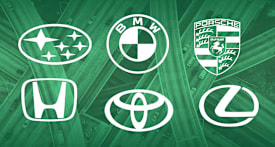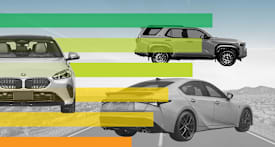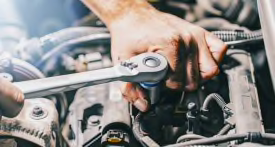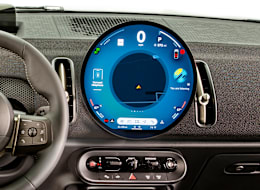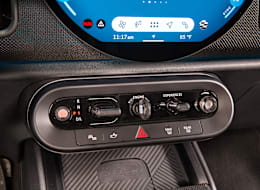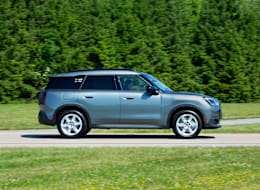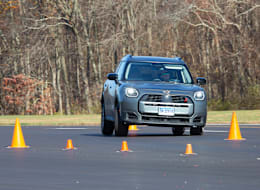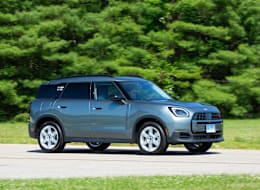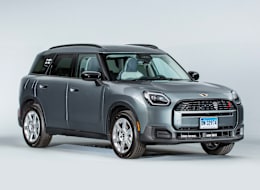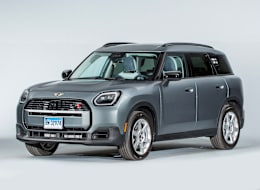This small SUV is the Mini brand’s largest vehicle, and it has been thoroughly redesigned for 2025. It has gotten bigger in just about every dimension, and it’s now about the same size as a Subaru Crosstrek. But unlike the plebeian Subie, the Mini tries to play in the entry-luxury space. It has an exterior design that looks a bit like a shrunken and more round Land Rover Defender and a fashionable interior with a unique circular touchscreen at the center of the dashboard. All-wheel drive is standard. The Countryman shares the same platform as the BMW X1 and the coupe-like X2.
It remains a charming and fun-to-drive car that’s also fairly practical, but uneven acceleration and confusing controls bring significant frustrations.
With Mini’s legacy of building fun-to-drive cars, this redesign is a mix of good news and bad. On the one hand, the Countryman’s handling is engaging, but the ride is pretty firm. The turbocharged four-cylinder engine has plenty of zip for merging and passing, but the seven-speed dual-clutch automatic delivers annoying power delays and hiccups at low speeds. Ultimately, the powertrain delivers disappointing day-to-day drivability which is somewhat tempered by the satisfying exhaust note. This all adds up to the Countryman being a conundrum.
The day-to-day living with this car had several drivers feeling less than enthusiastic. One stated “I so wanted to love this car. The size, packaging, styling, and creative details of the Countryman have a lot going for it. I have great memories of Mini Coopers that we've tested over the last 20 years, but this car is a total nightmare. The low-speed powertrain hesitation and constant electronic glitches take this Mini out of contention. I don't understand why the decision makers at BMW think that this car's engine and transmission are acceptable. Without any powertrain or infotainment updates, I simply don't want to drive this car anymore. What a shame.”
The Countryman’s interior is open and airy, and the creative touches inside the cabin made us smile. The front seats were not universally loved, however, but there’s a reasonable space in the cargo area.
We bought a 2025 Mini Countryman S All4 for $43,695—anonymously from an area dealer, as we do with every vehicle we test—for the purpose of this road test review.
Driving experience
The base 241-horsepower, 2.0-liter turbocharged four-cylinder engine has plenty of power to spare for merging and passing, and its sporty exhaust note adds to the fun. Driving the car in its sportier “Go-Kart” mode unleashed the Countryman’s livelier side.
The Countryman uses a seven-speed dual-clutch transmission (DCT). Although a DCT will shift gears for you just like a traditional automatic, behind the scenes it’s basically a manual transmission with two clutches operated by two robotic left feet. The benefit is that shifts are quicker than a traditional automatic. The drawback is that some DCTs—including this one—lurch and hiccup at low speeds as if those robots had just gotten their learner’s permits. Press on the gas pedal in stop-and-go traffic or when pulling away from a stoplight and the Countryman lurches forward initially, only to suddenly hesitate. One of our testers said it felt like the car was hiccuping, and a few of our passengers have asked us to drive more gently. It’s just one example of how the car feels like an unfinished project.
Ultimately, the Countryman proved quick with a 6.7-second dash in our 0-to-60-mph test—pretty good for the class. We also saw 28 mpg overall in our fuel economy tests, which is not bad, either, albeit on premium fuel. We are also testing the fully electric version, dubbed the Countryman SE All4, that promises 212 miles of driving range. Buyers looking to push the performance envelope can consider the sporty John Cooper Works version, which comes with 312 hp.
Most modern cars offer a few driving modes—sport, comfort, and the like. The Countryman has multiple “Experiences,” but they’re confusing. Some of them are just design themes, while others (Eco, Go-Kart) change the throttle mapping and shift points. However, this isn’t made clear to the driver, who may select an Experience based on how the speedometer looks and end up with a totally different throttle response, or vice versa.
And how much of this technical wizardry truly benefits driving it? One tester said “I don’t really find the Countryman particularly enjoyable or great to drive. I was expecting more of a fun driving experience, but I feel like all of the fun is just coming from gimmicky stuff inside.”
Although the Countryman feels more top-heavy than the smaller Mini Cooper two-door, it’s more nimble than most SUVs and proved to be a playful companion on twisty roads. It also acquitted itself well in our at-the-limit track handling exercises and aced all of our braking tests.
There is an underlying firmness to the ride but it remains reasonably comfortable overall. Sometimes, however, the suspension struggles to dampen sharp transverse ridges in the road. “It’s a firm ride and big bumps punch you right in the gut. Smaller stuff is absorbed in a controlled but only slightly more refined manner,” said one tester.
Noise levels are mostly chill, even on the highway.
Cabin comfort
The Countryman’s interior maximizes space, and the vehicle is easy to get into and out of. But the wide front seats don’t do a good job of holding you in place through corners. The rear seat is fairly comfortable and spacious for a small vehicle, with lots of headroom, tons of foot space, and good overall support. The squared-off design means there’s plenty of room for cargo in the back, too.
Mini added about 4 inches of headroom, and the results are truly impressive. The interior feels airy and spacious.
Some drivers said the faraway front windshield and thick side roof pillars took some getting used to, but we were mostly impressed by how easy it is to see through the Countryman’s vast greenhouse of windows.
It’s rare to find a car that has so many interior design details that can’t help but make you chuckle. For example, there’s a cool fabric strip acting as a steering wheel spoke, soft-to-the-touch material on the door panels, and plenty of variation in the plastic patterns across the upper dashboard. The upholstery on our Countryman’s seats features a “repeating M” pattern, too. Look closely and you can spot the requisite Union Jack flags here and there (even though the car is built in Germany). All these thoughtful touches make this a pretty special interior.
Controls and usability
The interior redesign did away with fussy metal switches that never worked quite right, replacing them with a 9.4-inch circular infotainment touchscreen screen—plastered in the middle of the dashboard—that also doesn’t work quite right. The new setup means that just about every task requires a multistep process through the screen. It’s attractive and unique, but we found that it occasionally lagged and didn’t always respond to our presses.
Because the Countryman’s main display for speed and vehicle information is in the middle of the dashboard, we highly recommend using the Countryman’s head-up display (HUD), which projects speed and other vital statistics on a small semitransparent panel that pops up from behind the steering wheel. Most other cars with a HUD project directly onto the windshield, and we wish Mini had done the same—especially because this car’s HUD is integral to keeping eyes on the road rather than looking over at the center screen. The HUD can be configured to show information such as speed, power and fuel gauges, ADAS settings, media, and phone calls. The pop-up panel really feels like an afterthought; at least the size and position of the projection can be adjusted. The HUD can be shut off and the translucent panel retracted, but then the driver is forced to turn to the right to look at the center screen as there is no dedicated instrument panel.
In addition, the climate controls are mostly placed along the side and bottom of the screen. The temperature controls work by sliding a finger up and down on the blue and red gradient, the same way that Volvo’s system is set up. Or, the user can press the tiny circle where the temperature is displayed and open a submenu. Both are needlessly difficult and distracting ways to adjust the climate while driving. However, we did like that you could swipe up from the bottom of the screen for customizable shortcuts, which made it easy to switch between Android Auto/Apple CarPlay and the Mini’s built-in controls.
The ignition switch is jumbled together with a number of other controls, including the electronic gear selector and “Experiences” switch; some of our testers found it hard to locate. We also had lots of issues pairing our phones and getting common apps to work.
Active safety & driver assistance
Standard active safety and driver assistance features include automatic emergency braking with pedestrian and cyclist detection, automatic emergency braking that operates at highway speeds, blind spot warning, rear cross traffic warning, reverse automatic emergency braking, lane departure warning, lane keeping assistance, and automatic high beams. Adaptive cruise control, lane centering assistance, and automatic lane change are optional. Rear occupant alert and rear belt-minder systems are also standard.
